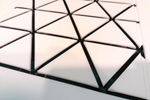Technology Innovation Institute AMRC explores novel metamaterial shapes for better shock, vibration shielding
Exploration of precisely engineered lattice structures including triple periodic minimal surfaces (TPMS) serve to develop more predictable, lightweight, high-performance sandwich cores.

Photo Credit: TII AMRC
Through the exploration of various combinations of new materials and new manufacturing processes, researchers at Technology Innovation Institute’s (TII, Abu Dhabi, United Arab Emirates) Advanced Materials Research Centre (AMRC) are exploring ways to precisely engineer new structures for more predictable, lighter weight and safer sandwich cores.
“If we combine these kinds of sandwich core with proper skin materials, in theory, we could develop a structure that can better resist impact and shockwaves,” notes Prof. Zhongwei Guan, executive director – Energy Absorption Composite Materials at AMRC.
According to TII, manufacturers have typically used aluminum foam as a core material, which often lead to foams in which the foam cell size and cell wall thickness are uneven. With the advent of 3D printing techniques, researchers are exploring lattice structures formed of regular-sized cells with controlled cell wall thicknesses. This leads to more predictable performance, says TII.
One particularly promising class of structures is formed of repeating patterns called triple periodic minimal surfaces (TPMS). These structures were first discovered in nature in the late 1800s. Over the years, researchers have discovered a variety of TPMS patterns. Recently materials researchers began exploring their relative strength-to-weight ratio for different scenarios.
Consequentially, TII researchers have decided to explore how five types of promising TPMS structures respond to high strain-rate loadings at three different relative densities. The different structures included Gyroid, Primitive, IWP, Diamond and Fisher-Koch patterns. In addition, they are interested in optimizing the lattice structure to maximize impact resistance and energy absorption. They are also exploring how graded lattice structures with different density layers may achieve better performance than a uniform lattice structure.
The current work focuses on creating metallic lattice structures that are better suited for vehicle armor due to their larger size. Down the road, TII says this research could also help reduce vibration and improve the sensitivity of instruments like telescopes or operating room robots. “The development of new materials that can resist blast loading with lighter weight could inspire people to think of new use cases,” says Sara Almahri, senior researcher at the AMRC.
This press release is based on the scientific paper “Evaluation of the dynamic response of triply periodic minimal surfaces subjected to high strain-rate compression.”
Related Content
-
Large-format 3D printing enables toolless, rapid production for AUVs
Dive Technologies started by 3D printing prototypes of its composite autonomous underwater vehicles, but AM became the solution for customizable, toolless production.
-
Lockheed Martin expands development, production of ultra-high temp CMCs with facility expansion
Targeting current and future needs in hypersonic and aeronautics applications, Lockheed Martin Skunk Works’ Allcomp team is increasing and digitizing its capabilities in ceramic matrix composite (CMC) materials and parts fabrication.
-
Plant tour: National Institute for Aviation Research, Wichita, Kan., U.S.
NIAR, located at Wichita State University in the heart of the American aerospace manufacturing industry, has evolved to become a premier hub of teaching, R&D, creativity and innovation.
















